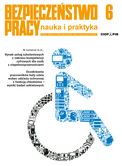Occupational safety of motorcyclists using protective clothing
Magdalena Zwolińska
Motorcycles have been a very popular means of transport since the 20th century. However, riding a motorcycle involves a greater risk of an accident than driving a car. Specialized motorcycle clothing and helmet are the only protection. Not only do they provide protection against the weather (such as rain, sun, wind) but, most of all, they are the only protection at the time of a fall or a collision with other vehicles or objects. Therefore, motorcycle clothing must meet the requirements concerning resistance to impact, friction, push or intersection. This article briefly discusses standards regarding motorcycle clothing as well as the subjective sensations of motorcyclists using those clothes
Violence at work – among women in the manufacturing industry
Magdalena Warszawska-Makuch
Violence at work is a complex, multi-aspect phenomenon that can assume various forms, i.e., mental violence (mobbing, harassment, intimidation), physical violence and sexual harassment. According to 2008 data from the Central Statistical Office (GUS), over 220,000 women in Poland have been exposed to some sort of violence at work.
In the manufacturing industry alone this number exceeds 40,000 women. This article attempts to determine some potential causes and forms of violence at work, especially in the context of women in the lowest positions in companies.
Fit and protection factor of respiratory protective devices - laboratory vs. reality
Krzysztof Makowski
This article presents basic methods of determining quantitative and qualitative fit factors for respiratory protective devices (RPD). Both types of methods have their advantages and disadvantages. The assigned protection factors used in selecting RPDs vary among countries. This article also discusses the results of studies and the fact that the dispersion in the values of fit factors at workstations is much greater than in values obtained in reproducible laboratory conditions. Therefore, to ensure workersʼ safety, fit and the protection factor should be assessed whenever an employee is assigned an RPD.
Assessment of noise exposure at call center workplaces throughout measurement method and MIRE technique
Bożena Smagowska, Witold Mikulski, Jan Radosz
This article presents the assessing noise exposure at telephone consultants workplaces using headpset. The study is based on a method compliant with PN-EN ISO 9612 and PN-EN ISO 11904-1 standards. The evaluation of exposure was conducted in accordance with the regulation of the minister of labor and social policy dated November 29, 2002 regarding the highest permissible concentrations and intensities of health damaging factors in the work environment (due to the hearing protection) and the PN-N-01307 standard, (the ability to perform basic tasks in the work process).
Thermal load of employees working in hot environment and methods of its reduction
Grażyna Bartkowiak, Anna Marszałek, Anna Dąbrowska
According to the data from the Central Statistical Office from 2011, approx. 20 thous. people in Poland is exposed to the risk of working in hot microclimate. Due to the harmful effects on the functioning of the human organism of a long-term work under high temperatures, it is necessary to identify hot workplaces and to try to minimize the heat load of employees.
This article describes how to evaluate the thermal load of people working in a hot environment, in accordance with PN-EN 27243:2005 (determination of WBGT coefficient), as well as the terms and conditions prevailing on the selected hot workplaces: the heat and power plant, steelworks, bakery and confectionery, and mining.





























